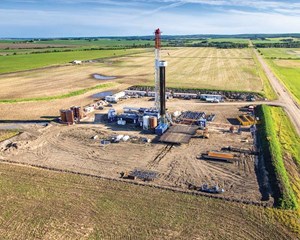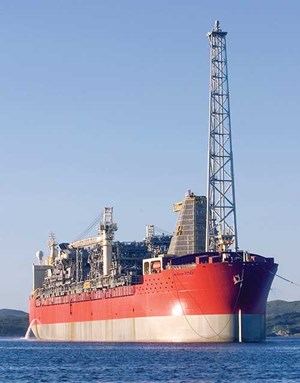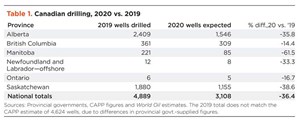Canada faces historically low activity levels with little price relief
Times are grim in the Canadian oil patch. Months into the Covid-19 shutdowns across the country, producers have reduced spending to almost nothing. Job postings are rare, and in Calgary, the unofficial oil capital north of the 49th parallel, the customary bustle of a downtown dominated by oil and gas companies is eerily quiet most days.
In this unprecedented year, attacks on the oil and gas industry from environmental extremists continue unabated, bolstered by opportunistic politicians, a hapless federal government, and a provincial Alberta government, whose Covid response and heavy-handed tactics have eroded public trust. There is still some optimism that things will improve through the second half, but it is understandably dim, Fig. 1.

Alberta has suffered far greater than most Canadian provinces, with a double whammy of low industry activity and the Covid-19-driven economic malaise. The Conference Board of Canada forecasts that Alberta’s GDP will fall more than 11% this year, the worst in the country.
Adding to the uncertainty is the federal government, which vacillates between punitive anti-oil policies and multi-billion dollar investments in the beleaguered ‘patch. On the West Coast, British Columbia’s minority government (propped up by the Green Party) continues to fight the development of oil and gas pipelines, even while issuing a string of bizarre, seemingly pro-development news releases.
This spring, the federal government unveiled a bailout package for the oil and gas industry, comprised of loans, financing and, of course, climate change conditions. Luckily, most companies are already responsible producers and will have little difficulty meeting the conditions.
Alberta’s provincial government announced in June a C$10-billion infrastructure plan to stimulate its moribund economy. The plan includes building pipelines and petrochemical facilities, as well as roads and other infrastructure. The announcement follows the government’s spring announcement that it would invest C$1.5 billion in the Keystone XL pipeline, and provide TC Energy with a $6-billion loan guarantee.
Relations have worsened significantly between Alberta and BC politically, arguably hitting their nadir when BC Premier John Horgan refused to condemn acts of vandalism in BC against vehicles with Alberta license plates, including several instances of individuals keying Alberta cars and loosening lug nuts on wheels, resulting in dangerous accidents. Notably though, many BC businesses and communities have gone out of their way to ensure that Albertans feel welcome in BC.
The federal scene is particularly murky. After plunging the country into record debt levels, there is speculation the Liberal minority government may provoke a vote of non-confidence in Parliament—which would precipitate an election if they lose—in an attempt to take advantage of the Conservative party, which just elected a new party leader. The Liberals would hope to secure a majority government with the Conservatives seemingly unprepared for a sudden election.
Pipeline sector. With so much going on, it is easy to lose sight of the ongoing lack of market access via pipeline that continuously hamstrings the Canadian industry. On a positive note, the Supreme Court of Canada dismissed the latest, and final, appeal from British Columbia First Nations over the Trans Mountain pipeline expansion in July. The dismissal effectively ends the legal battle against the project.
In the near term, the victory seems hollow, as production has fallen so dramatically. Crude-by-rail shipments, which grew exponentially as producers sought to get their product to market, fell almost 70% during second-quarter 2020, according to Canadian Pacific Railway Limited. Industry officials hope that the increased pipeline capacity will be matched by a return to normal production levels next year, and beyond. Further legal obstacles, south of the border, to the 830,000-bopd Keystone XL pipeline have also dimmed optimism that market access will improve any time soon.
Canada achieved an historic milestone this July, when Calgary-based Cenovus Energy sold a shipment of crude to Saint John’s Irving Oil Limited refinery. But because of political opposition to pipeline development that could potentially ship western crude to eastern Canadian refineries, this shipment came via crude oil tanker, by way of the Panama Canal. The odd arrangement is primarily a result of the federal government’s refusal to assert its legal primacy on matters of national energy policy, as well as its fear of opposing the provincial government of Quebec, which staunchly opposes pipeline development across its territory, because this supports “dirty energy.”
The irony of this is “rich,” as Canada’s system of equalization payments between provinces has resulted in Alberta paying hundreds of billions of dollars over the years, primarily due to its oil and gas wealth, and Quebec has been by far the biggest beneficiary, netting some C$200 billion, to date. Meanwhile, Quebec communities regularly dump raw sewage into waterways, with some 60,000 sewage dumps recorded in Quebec annually.
Oil sands. Because their production cycles are counted in decades, Alberta’s oil sands are better positioned than most to weather this storm. But their path is not easy. The favored target of environmental activists (who tweet their venomous attacks from smart phones made with oil products), oil sands producers soldier on, despite economic conditions and legal setbacks.
For example, Prosper Petroleum Ltd.’s plans to construct and operate the C$440-million, 10,000-bpd Rigel Steam Assisted Gravity Drainage (SAGD) project in the Athabasca oil sands was appealed successfully by the Fort McKay First Nation this spring. A judge ruled that the Alberta Energy Regulator should have considered the incomplete Moose Lake Access Management Plan (MLAMP) between Alberta and Fort McKay in its decision.
The objective of the plan is to address the cumulative effects of oil sands development on the First Nation’s treaty rights. Unfortunately for Prosper and the AER, the plan has been “in development” for years. In August, the AER announced that it will reopen the public hearing for the SAGD project.
Meanwhile, other oil sands operators are staying the course, albeit with considerably less spending, and mounting losses through first-half 2020. Imperial Oil, for example, announced that it was doubling the turnaround time at its Kearl mining project, resulting in efficiency gains that resulted in record production during the first half, and technical improvements that will benefit the operation’s long term.
In a typical year, market volatility would mean a number of mergers and acquisitions, as companies with good balance sheets take advantage of those looking to sell. But there is nothing typical about this year, so a lack of M&A activity should come as no surprise. Some industry experts expect to see M&A activity heat up in the second half, as conditions stabilize. In August, ConocoPhillips picked up acreage in BC’s Montney shale from Kelt Exploration for $550 million in a cash-and-debt deal.
In 2019, only a handful of deals were completed through the first half in Canada, valued at C$5.4 billion. As noted previously, spending is down substantially in 2020. Canadian Natural Resources Limited (CNRL) announced this spring that it was reducing its capital plan to C$2.96 billion, down more than 25% from its original $4-billion target.
Suncor Energy also announced a similar cut in March, dropping its spending plans to C$3.9 billion to $4.5 billion for 2020. This compared to an original budget of up to $6 billion.
Normally, prognosticators would view land sale totals and drilling numbers as two key indicators of the industry’s overall health—drilling for the present, and land sales for the future. This year is different. Both BC and Alberta have suspended land sales in response to the Covid-19 downturn. Alberta has only committed to reviewing whether it will resume in the fall.
Drilling numbers are also skewed, with record lows across the country, and Saskatchewan regularly showing an active rig count of zero. As a result, comparative numbers are almost meaningless.
Drilling has fallen substantially, with 1,936 wells drilled through June, down 17% from 2,319 during first-half 2019, according to Daily Oil Bulletin records. But the trend is downward, with only 34 wells drilled in June, a new historical monthly low, and 90% lower than June 2019.
According to World Oil’s survey results, the Canadian Association of Petroleum Producers is forecasting a significant reduction in drilling this year, to 3,108 wells drilled (Table 1), a decrease of nearly 33% from last year’s total of 4,624. Meanwhile, the Canadian Association of Oilwell Drilling Contractors has stuck with its original November 2019 forecast of 4,905 wells drilled this year, which is basically unchanged from the association’s 2019 levels.
In contrast, the Petroleum Services Association of Canada issued its third forecast revision in July, predicting
that 2,800 wells will be drilled this year, This is substantially lower than its original projection of 4,500 wells, issued last October.

Offshore East Canada. For six months, Canada’s offshore upstream industry, centered in St. John’s, Newfoundland and Labrador (NL), has tried to get federal assistance, in the form of temporary tax breaks (similar to Norway), to overcome the depressed market caused by the Covid-19 pandemic and low commodity prices. As this issue went to press, the administration of Canadian Prime Minister Justin Trudeau had yet to fulfill the expectations of NL officials and industry leaders.
This is despite Canadian federal officials—principally Natural Resources Canada Minister Seamus O’Regan—originally declaring between mid-April and June 4 that they recognized that the NL offshore oil and gas industry is important, and that action would happen “soon.” Yet, for three months after June 4, the federal administration was nearly silent, despite a concerted public lobbying effort by the Newfoundland and Labrador Oil and Gas Industries Association (Noia).
On Sept. 3, Trudeau spoke with a local radio host in St. John’s about the NL offshore industry. And yet, said Noia Chair Karen Winsor, “There was no response provided that indicated support was coming for Newfoundlanders and Labradorians to help to stop the bleeding.”
The Trudeau administration may have received the ultimate wake-up call on Sept. 9, when Husky Energy announced a review of the West White Rose Project (Fig. 2) in the Atlantic region. “Unfortunately, the delay caused by Covid-19 and continued market uncertainty leaves us no choice but to undertake a full review of the project and, by extension, our future operations in Atlantic Canada,” said CEO Rob Peabody.
- The last barrel (February 2024)
- Oil and gas in the Capitals (February 2024)
- What's new in production (February 2024)
- First oil (February 2024)
- E&P outside the U.S. maintains a disciplined pace (February 2024)
- Prices and governmental policies combine to stymie Canadian upstream growth (February 2024)



